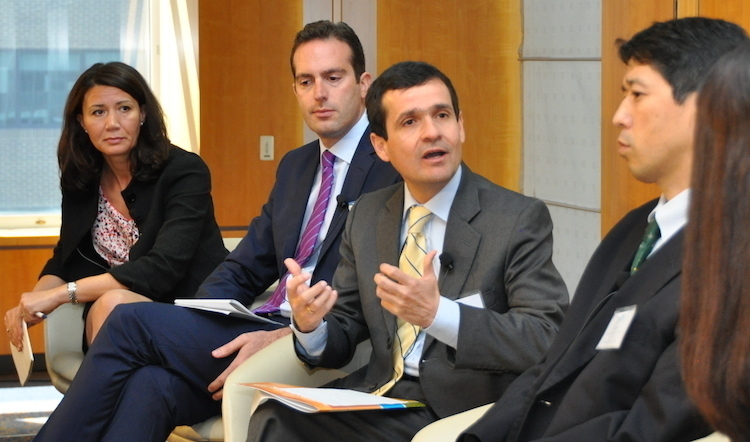‘We Need to Partner More’: Business Call to Action panelists discuss new ways of thinking necessary to achieve SDGs
The best way to achieve the Sustainable Development Goal (SDG) of “ensuring healthy lives and promoting wellbeing for all at all ages” is through innovative cross-sector collaborations.
That was the takeaway from a breakout panel discussion – “Toward a Healthier Future: Catalyzing Partnerships to Drive Better Health” – at the Business Call to Action’s sixth annual forum in New York City on Sept. 24, the day before the SDGs were formally approved by the United Nations only blocks away.
A corollary to the takeaway: The recommended collaborations won’t happen unless many entities, both public and private, shift their old ways of thinking.
The panelists, all of whom have experienced just such a shift, were Soraya Ramoul, director, Access to Health, Novo Nordisk; Daniel Grossman, senior director, Global Health Innovation, Medtronic; Camilo Gonzalez Ruiz, director of access, diabetes, Sanofi Colombia; and Takeo Hojo, general manager, BOP Business Unit, Global Operations Division, Saraya. Natasha Sunderji, global health lead, Accenture Development Partnerships, served as moderator, and Dr. Joseph Kibachio, head of the Non-communicable Diseases Department at Kenya’s Ministry of Health, gave closing remarks.
Asked if the SDGs might bring new “actors” to the table, as compared to those working to reach the Millennium Development Goals (MDGs), Ramoul replied, “You want the honest answer? I don’t see the dialogue being very different from the dialogue we see with the MDGs.” She’s hoping that governments will start to seek out partnerships, instead of “enlightened businesses” always taking the lead in seeking opportunities.
Kibachio, as the lone public-sector representative in the group, agreed. “The MDGs, to some extent, to us in government, look like you are throwing money at the problem. … But for the SDGs, we are asking (private organizations) to come on as partners.
“I’ve met people here I’ve never met in Kenya,” Kibachio said, drawing laughter. “That just tells you we need to partner more.”

(The panelists, left to right: Soraya Ramoul of Novo Nordisk, Daniel Grossman of Medtronic, Camilo Gonzalez Ruiz of Sanofi Colombia and Takeo Hojo of Saraya.)
For the past 50 or 60 years, Kibachio said, developing countries have had an “illness model” in place, with well-publicized maladies like HIV, TB and malaria getting most of the funding. Meanwhile, more people in his country are dying from non-communicable diseases (NCDs) like diabetes and hypertension, he said, and he hopes the SDGs will be more about investing in people, rather than diseases.
“The biggest challenge is to make a business case that the cost of inaction (on NCDs) is more costly than the cost of action. That has been the missing link.”
Ruiz said his firm deals with a lot of HMOs in Colombia and, since they manage public funds, are hesitant to work with private entities. But they will ultimately engage, he said, if the private firm can prove there’s value in it. “In general, the environment is building trust,” he said.
Grossman, of Medtronic, said that as the model in developing countries changes from philanthropy-based health care to a business-based, partnership model, private entities seem to be ahead of governments. But the private entities themselves – including Medtronic – are continuing to evolve.
Medtronic’s model of collaboration historically involved identifying a partner and giving them funding up front, in order to reach a certain goal. These days, he said, the idea is to find a partner to help build a model that works in a specific area, with revenue eventually feeding back to the partner as the model takes hold.
Even the way Medtronic thinks of itself has changed, he said. It’s not just a medical device company, but holds itself responsible for medical outcomes and access, and that requires empathy, listening to customers and understanding local needs.
Ramoul pointed out that Novo Nordisk has changed, too, and gave an example: It came up with a new business model to address insulin supply chain problems in Kenya – creating incentives all along the chain – and ultimately was able to reduce the price by two thirds.
Hojo described how his firm, which manufactures and sells hand disinfectant in Uganda, had to create a market in a country where none existed. That involved a lot of stakeholders across many sectors, and “creating a new normal” in the company.
Kibachio also talked about a new normal in his conclusion. Where governments have always seemed to approach problems in silos, he said, they’re now changing their thinking and understand that they need businesses to play a greater role in finding health care solutions. And that, he said, ultimately involves more than money: “We need to empower people and families and communities.”
Kyle Poplin is the editor of NextBillion Health Care.
- Categories
- Environment, Health Care, Social Enterprise
